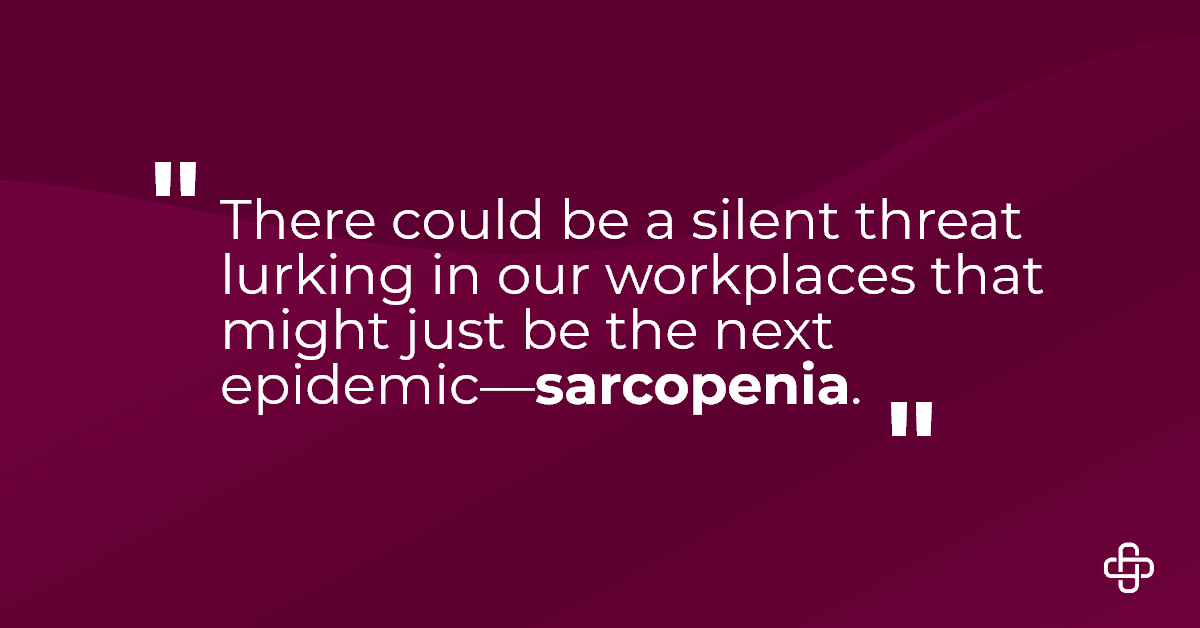There could be a silent threat lurking in our workplaces that might just be the next epidemic—sarcopenia.
This condition, characterized by low muscle mass and strength, could quietly impact businesses more than anticipated.
Understanding sarcopenia’s implications is crucial for employers and employees. This post will unravel the mysteries of sarcopenia, its potential impact on the workforce, and what measures can be taken to address it.

What is Sarcopenia?
Sarcopenia, coined by Dr. Irwin Rosenberg in 1988, denotes a significant reduction in muscle mass and strength. This muscle loss is a natural part of aging and a condition that requires attention.
Often termed a muscle disease, sarcopenia can lead to reduced physical performance and an increased risk of falls and injuries.
Understanding this condition is the first step in addressing its consequences in the workplace.
How Sarcopenia Affects the Workforce
The impact of sarcopenia on the workforce cannot be overstated.
With an aging population, more workers are staying active in the workforce beyond the age of 60, increasing the prevalence of sarcopenia individuals.
This condition often leads to higher healthcare and workers’ compensation costs due to increased susceptibility to injury and illness.
The Financial Burden of Sarcopenia
Sarcopenia isn’t just a health concern—it’s a financial one, too.
In 2000, sarcopenia cost the U.S. an estimated $18.5 billion. If preventive measures aren’t taken, expenses are projected to soar to $800 billion by 2040.
Hospitalized sarcopenic patients incur costs ranging from 18% to 75% higher than their non-sarcopenic counterparts. Employers must be aware of these figures as they plan for the future.
Assessing and Diagnosing Sarcopenia
Diagnosing sarcopenia is challenging due to the lack of standardized assessment tools. While DEXA scans remain a gold standard, they’re costly and time-consuming.
Emerging predictive models using hand grip strength, calf circumference, and gait speed offer promising alternatives.
Once validated, these methods could provide more accessible and affordable solutions for early detection in the workplace.
The Health Implications of Sarcopenia
Sarcopenia has far-reaching health implications. It is linked to various chronic conditions, such as:
- Type 2 diabetes
- Hypertension
- Cardiovascular Diseases
Additionally, it increases the risk of cognitive decline and mental health issues like anxiety and depression.
For employers, understanding these connections emphasizes the importance of addressing muscle health proactively.
Risk Factors and Prevention Strategies
Several factors contribute to the development of sarcopenia, including:
- Aging
- Chronic Diseases
- Lifestyle Choices
However, it’s not an inevitable part of aging. Resistance exercises, performed 2-3 times a week, can significantly reduce the risk of muscle loss.
Encouraging employees to incorporate regular strength training into their routines can be a game-changer.
Nutritional Support for Muscle Health
Diet plays a pivotal role in combating sarcopenia. After age 60, protein intake should increase to at least 1 gram per kilogram of body weight daily.
Supplements like Vitamin D and antioxidants are also beneficial. Employers can promote nutritional awareness and provide resources to help employees maintain a balanced diet.
The Role of Employers in Combating Sarcopenia
Employers are uniquely positioned to positively influence their workforce’s health.
Implementing wellness programs focusing on strength training and nutrition can mitigate the effects of sarcopenia.
Fostering a culture that encourages physical activity, and healthy habits can lead to a more robust and productive team.
Creating a Safe and Supportive Work Environment
To address sarcopenia effectively, creating a safe and supportive work environment is essential.
Ergonomic workspaces, flexible schedules, and opportunities for physical activity during work hours can make a significant difference.
Employers should prioritize these changes to enhance employee well-being and productivity.
The Importance of Employee Education
Education is a powerful tool in the fight against sarcopenia. Employers should offer additional education on muscle health, exercise, and nutrition.
By empowering employees with knowledge, businesses can inspire lasting lifestyle changes that benefit individuals and the organization.
The Future of Sarcopenia Awareness
The U.S. Department of Health and Human Services recently launched a sarcopenia awareness campaign.
However, more efforts are needed to standardize diagnostic criteria and promote early intervention.
By collaborating with healthcare professionals, employers can stay informed about the latest developments and best practices.
Conclusion
Sarcopenia presents a formidable challenge to the workforce, but it can be met with proactive measures.
By implementing wellness programs, promoting nutritional awareness, and fostering a supportive work environment, businesses can mitigate the impact of sarcopenia and create a healthier, more productive workforce.
Charli Pedersen is a published writer featured on Axiom Medical’s blog. She holds a bachelor’s degree in English, Professional and Technical Writing, and has experience creating content for businesses and non-profit organizations.










